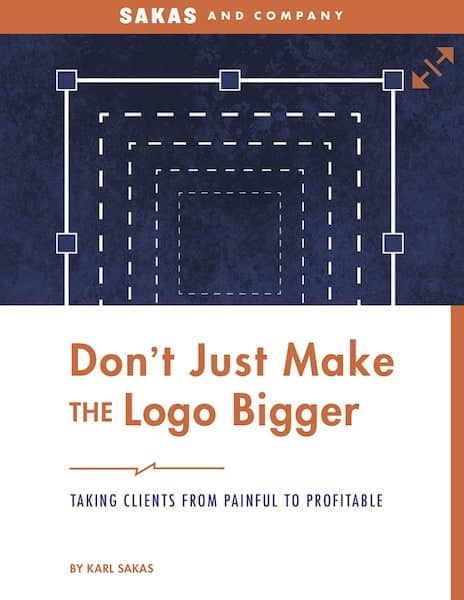A client who does sales at a video production agency recently asked:
“[How do other] agencies typically handle payments? For instance, we require a 50% deposit before we begin a project. But, depending on the client’s deadline we often begin working on the spot before they’ve paid that deposit…which sometimes becomes an issue.”
Another client came to me reporting cashflow problems at his web design agency. One of the biggest problems came from how he structured project milestones. Because he was doing 50% up front and the rest due on completion, he faced unexpected—but predictable—delays on collecting the last half.
Let’s look at deposits at digital marketing agencies—how much to charge, how to structure milestone payments, and what to do when clients drag their feet on paying deposits and other milestones.
How much should marketing agencies charge up front as a deposit?
I recommend charging a deposit of 20% to 50% up front. Your goal is to get a commitment from the client to doing the project. (See below for my advice on retainers.)
The exact amount should depend on how your work unfolds, and on the project size and timeline. Smaller and shorter projects should have bigger deposits (on a percentage basis). Bigger and longer projects should have smaller deposits (on a percentage basis).
How big should project milestones be?
Your goal should to ensure payment progress keeps up with project progress. Few things hurt more than realizing your client is delaying payment when you’ve already done a ton of work for them.
Big Projects
However you define big projects at your agency, I recommend getting at least a 20% deposit from clients—and you could do as much as 33% if you split the project into thirds.
If you’re doing a $100,000 website project, think about the stages of the project and the work involved, and define your milestones based on that. That $100,000 might hypothetically divide into these steps:
- Milestone A: $25,000 up front
- Milestone B: $10,000 after design signoff
- Milestone C: $20,000 on building the main site templates
- Milestone D: $15,000 on building a specific piece of unique functionality
- Milestone E: $20,000 on launch
- Milestone F: $10,000 after completing the client’s post-launch punchlist for items identified in the first two weeks after launch
On big projects, never do do 50/50 milestones (half up front, half on completion)—you’re taking a big risk. Getting that last 50% is a great day for your bank account, but if a client delays final signoff or other issues came up, you might find you’ve done 80-95% of the work but received just 50% of the compensation. Don’t do it.
Medium-Sized Projects
For mid-sized projects, I’m a fan of doing 50% up front, 25% at a significant later delivery, and 25% at the end. Clients make a significant investment for you to get started, and getting an additional 25% before the end of the project means (worst-case) you might have done 80-95% of the work but at least you’ve also gotten 75% of the compensation.
Small Projects
If it’s a small project that you can finish in a day and it’s for an existing client who pays on time, you might be OK billing 100% afterwards, or 50% in advance and 50% on delivery.
If it’s something tiny for a new client, considering billing 100% in advance. Not every client will want to do that, but if they can’t trust you with a few hundred dollars, what are they going to be like to work with?
And think twice about doing tiny projects for new clients—sometimes it can lead to future work, but I find that’s rarely true—you just wasted several hours of onboarding time to get a few hundred dollars (or a few thousand dollars) in lifetime revenue.
Should we trigger milestones on delivery or on client approval?
You’d prefer on-delivery; your clients would prefer on-approval.
As you’ve seen, client rarely approve the first version they see—there are usually at least some revisions. In your Statement of Work (SOW) I recommend including either rounds of revisions (e.g., three rounds after part 1, two rounds after part 2) or a dollar or time budget for revisions (e.g., they can make as many revisions as they want as long as it takes less than three hours of work).
How do you get clients to pay on delivery?
But how do you get clients to pay you on delivery, before you make the revisions?
Answer—by structuring your SOW to include a feedback-and-revisions deliverable at the beginning of the next milestone. That way, the client isn’t signing off on loving what you just gave them—they’re just signing off that they received it. Then, when you make revisions, that’s already part of the next milestone—and there’s no reason for them to delay payment on the previous milestone.
What about retainers? Should clients pay in advance or afterwards?
I recommend collecting retainers in advance. Why? Because then you’re not reliant on the client paying on time.
Don’t forget, they don’t pay immediately anyway—if you bill Net 30 at the end of September for work you did that whole month and the client pays by the end of October, it took you as much as 60 days between doing the work (in early September) and getting paid (in late October).
Getting paid in advance—with new clients
If you don’t do this now, switch your new clients to paying retainers up front. If they want to work with you, they’ll pay. And if they balk, think about your agency’s positioning—in-demand agencies can demand more from clients.
What if we do Agile instead of Waterfall?
If you’re doing Agile, bill clients by the sprint. If they haven’t paid, you can delay starting the next sprint ’til they’ve paid.
Nothing motivates clients to pay on time than your ability to withhold work due to their being past-due.
And if the clients don’t care… you need to work on your positioning. Remember, in-demand agencies can demand more from clients.
What can we do if clients are taking forever to pay the deposit?
Remember the second half of the question before, from my client at a video production agency:
“depending on the client’s deadline we often begin working on the spot before they’ve paid that deposit…which sometimes becomes an issue.“
When it comes to getting the deposit vs. starting work, this becomes a situation about who’ll blink first. I like saying that We’re eager to get started but we can’t schedule the kickoff meeting ’til after receiving the deposit.
That’s right, don’t even schedule the kickoff meeting ’til you’ve gotten paid.
Why? Because if you’ve scheduled the kickoff meeting but the date’s approaching and your client still hasn’t paid, it creates an awkward situation. Whereas if they have to pay to make kickoff happen, they have to prove (with their payment) that they want to get started as fast as they claim.
How do we apply this at my marketing agency?
I’ll share more about this (including my “R-O-C” framework for saying “no” when a client wants to hear “yes’) at my free Client Service talk in Raleigh on October 28, 2014.
And for more on agency sales advice, check out my series of 3 agency sales webinars in November 2014—just $75 each, or get bonuses worth $250+ if you sign up for all three.
Question: How do you handle deposits at your digital marketing agency?


